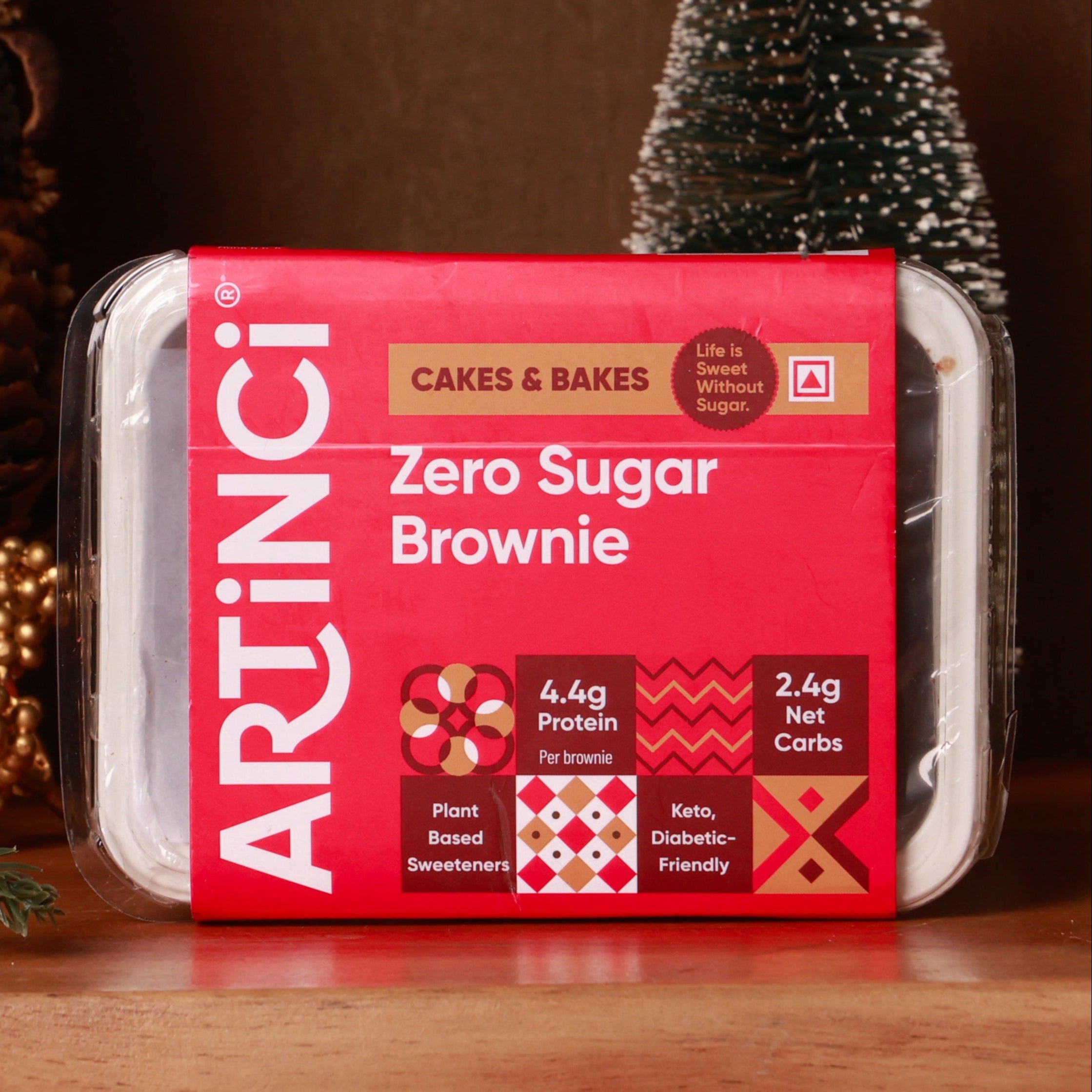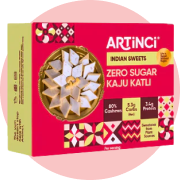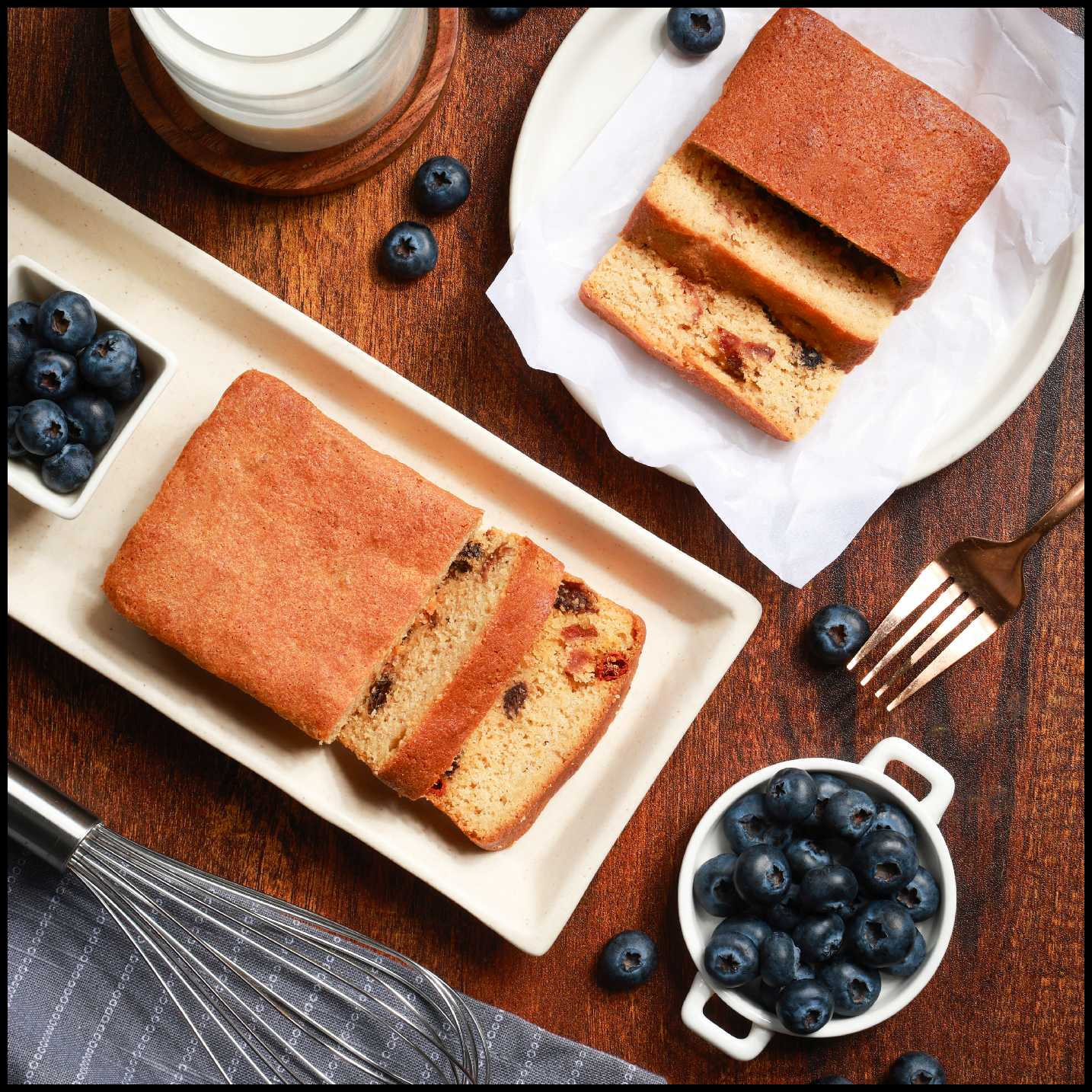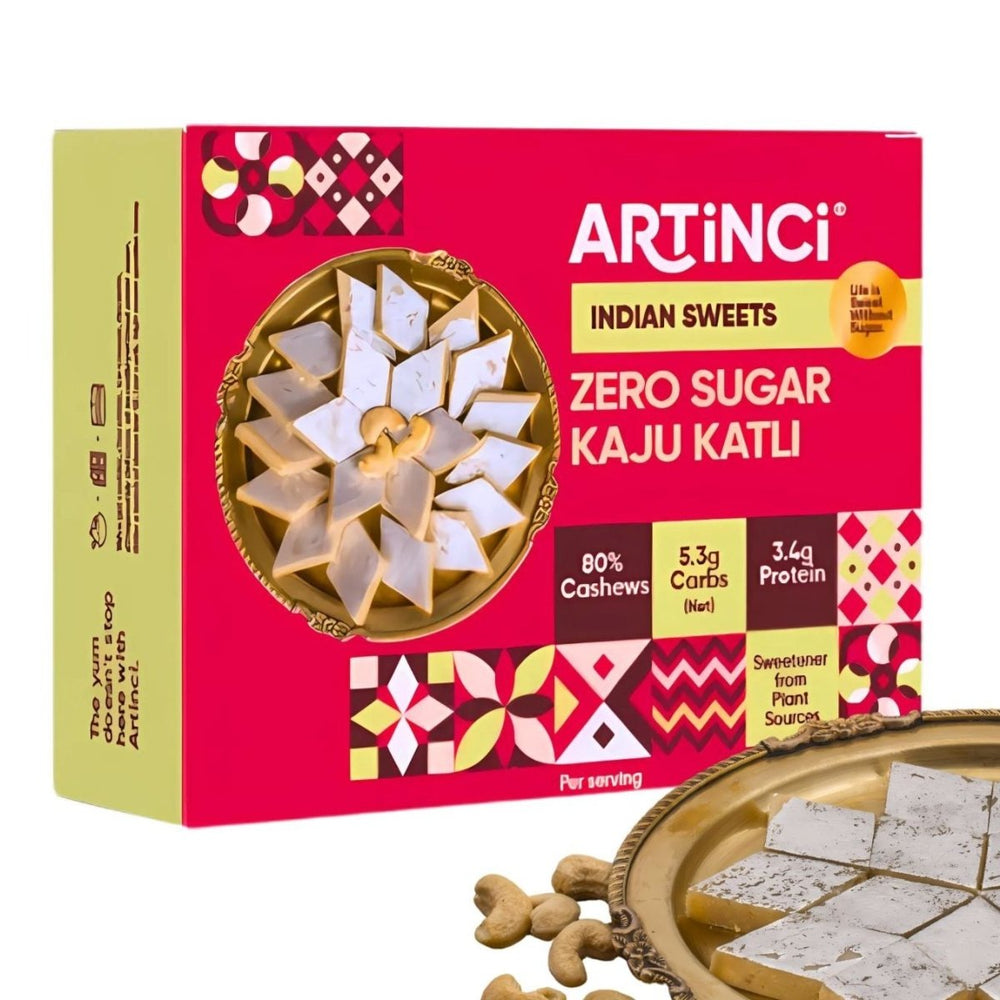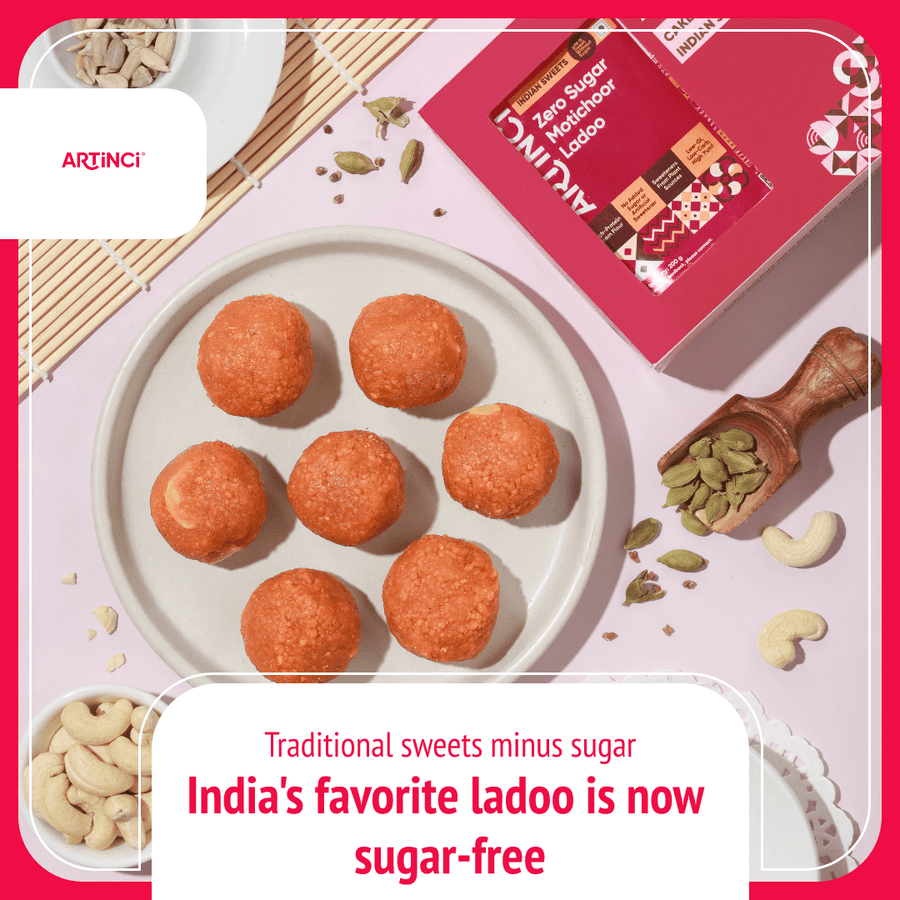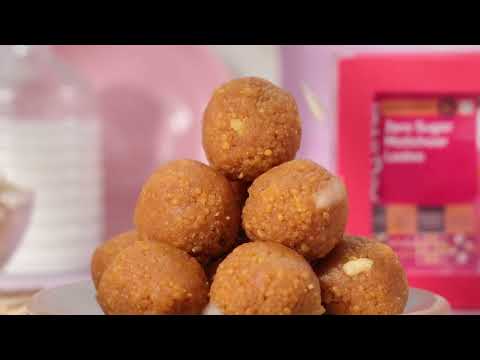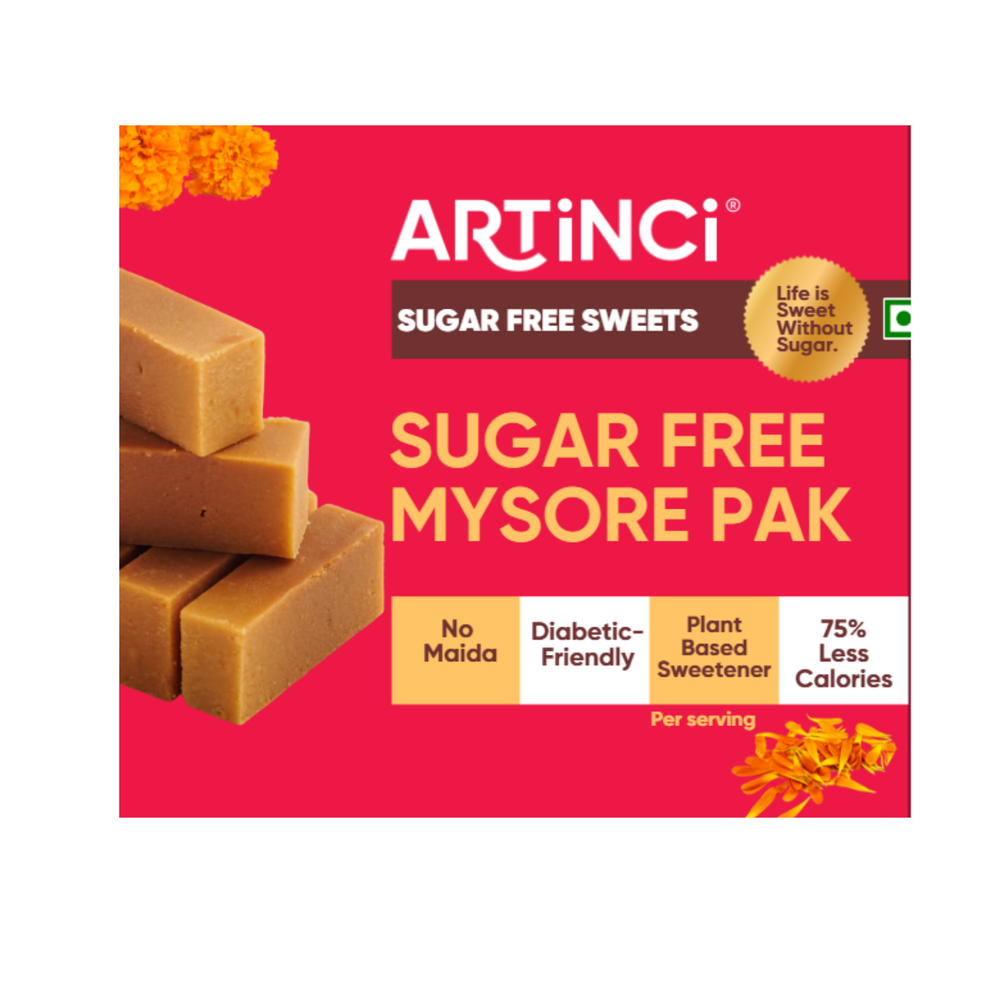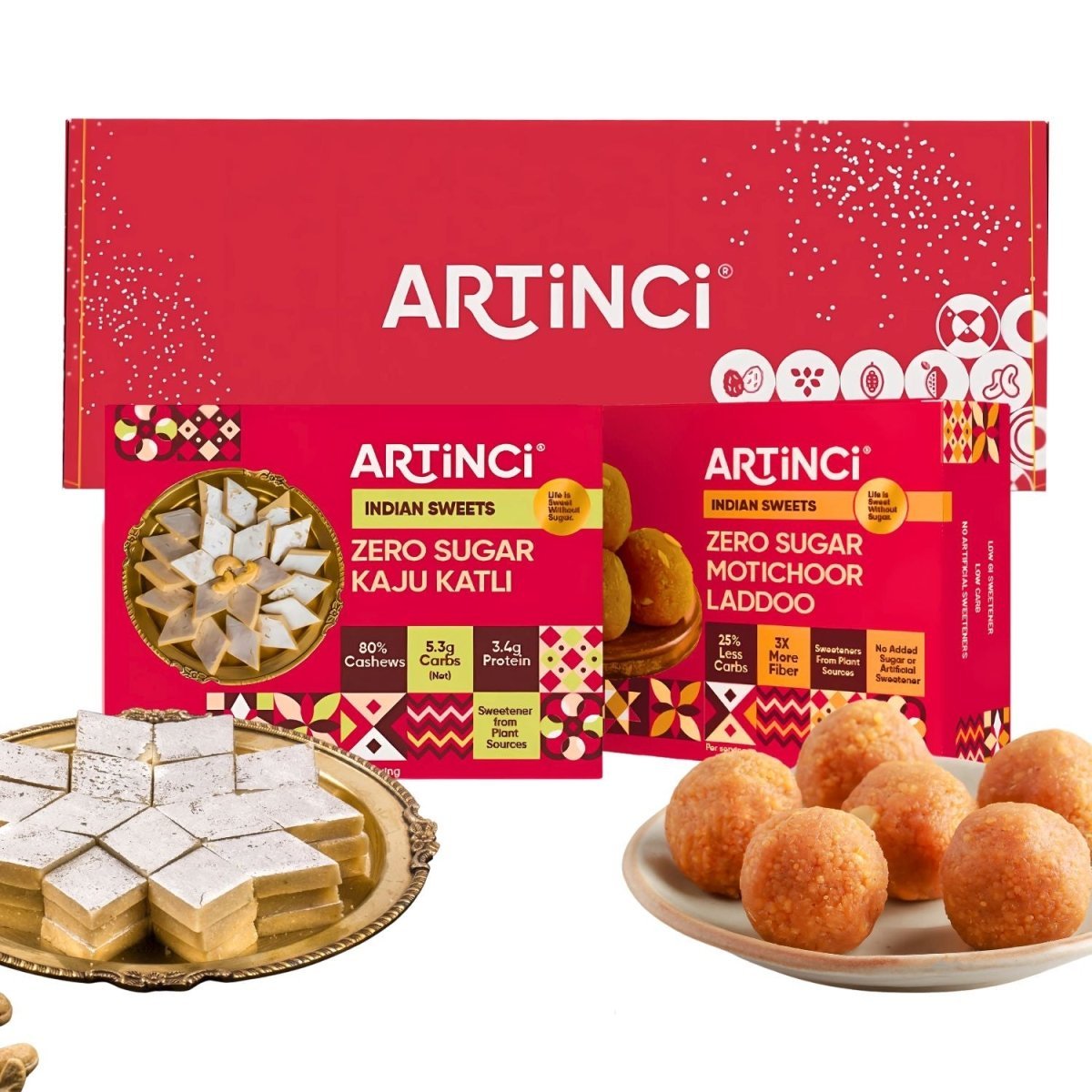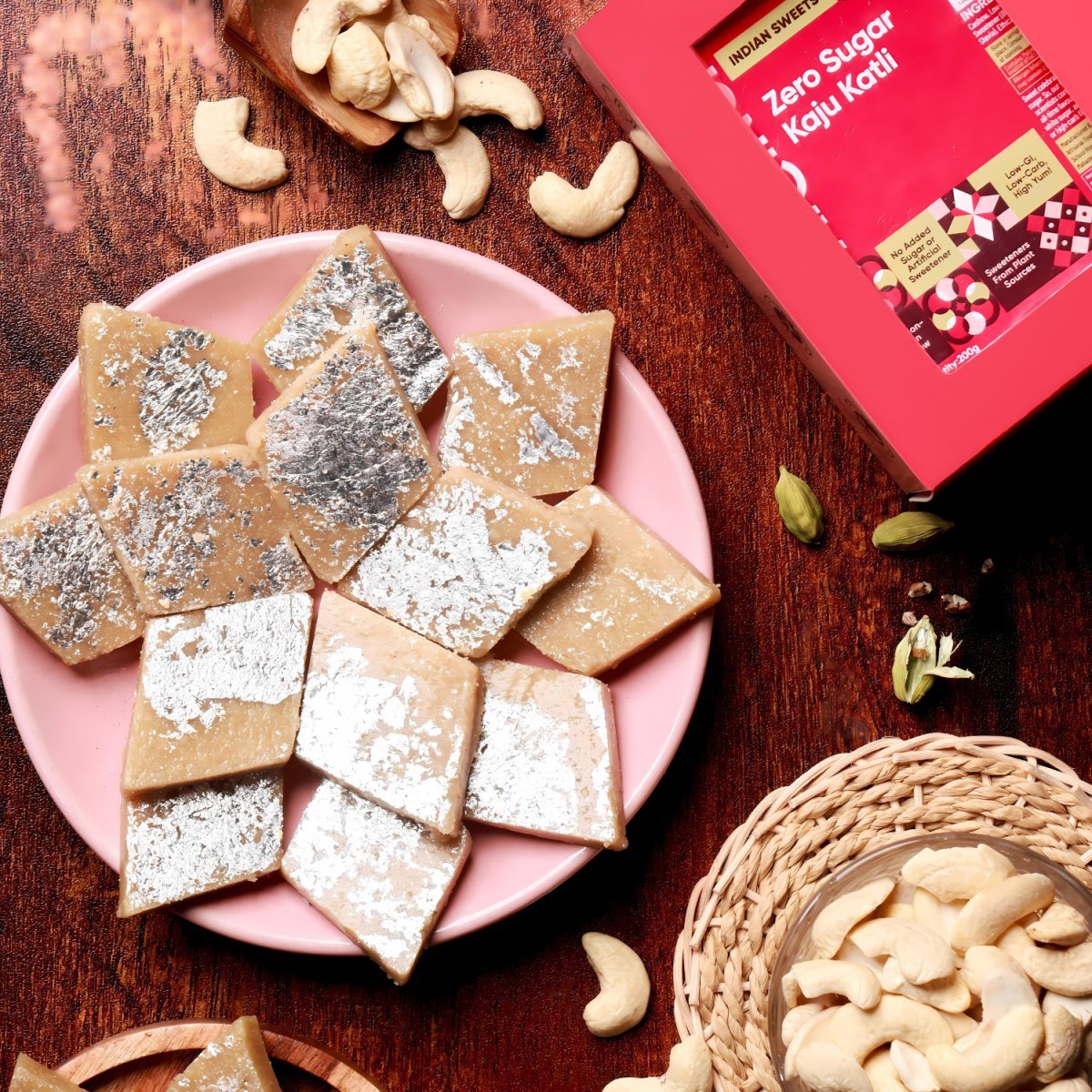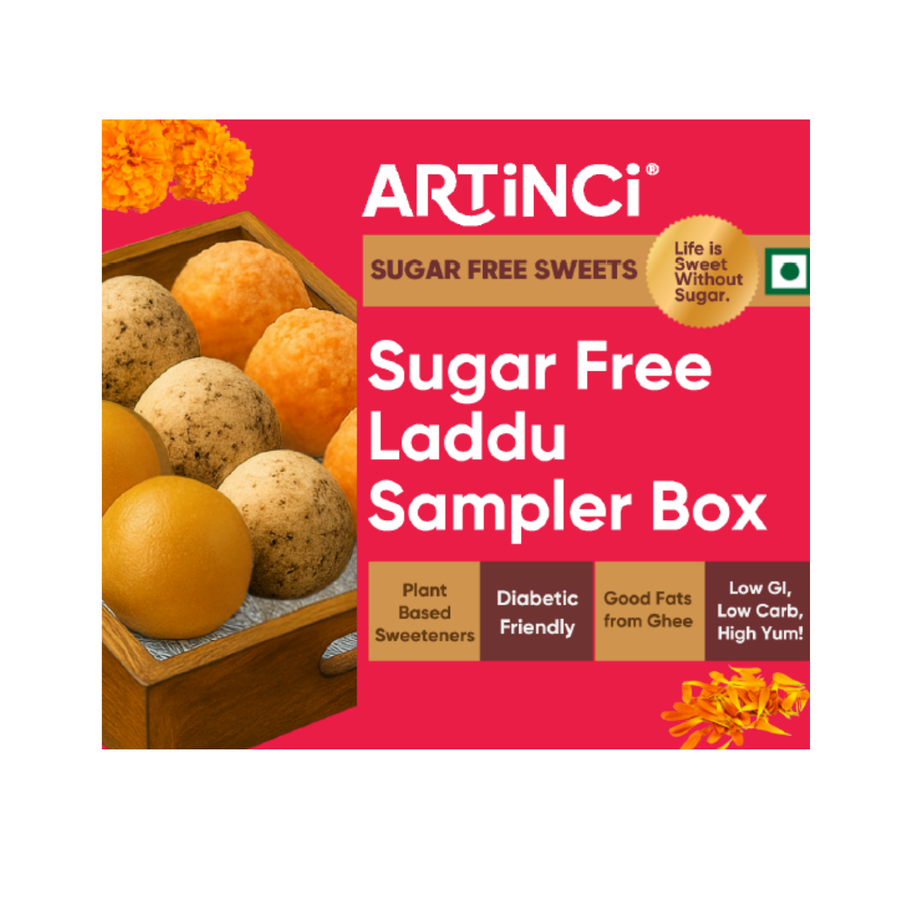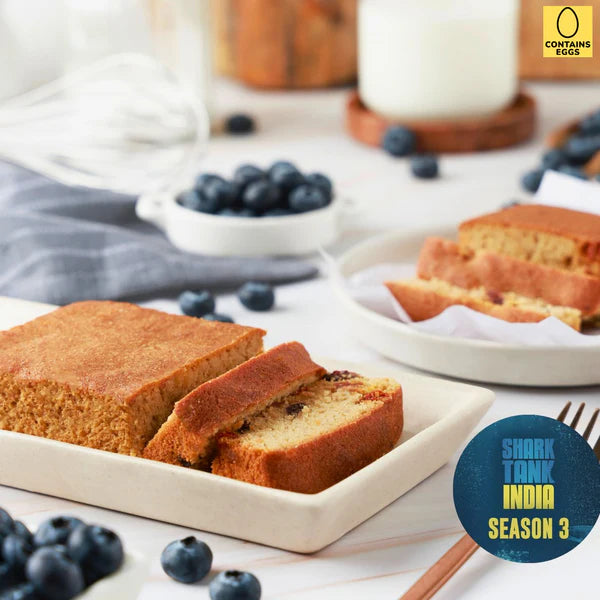Welcome to the world of sugar free joy!
Low Carb Sugar-Free Desserts & Snacks
Artinci was born out of Aarti's and Sumit's (Artinci's founders) abiding love for great-tasting dessert, while helping them stay committed to their health goals as well. As a result, Artinci makes delicious desserts with zero sugar, that are science and evidence-backed.
Aarti and Sumit come from a family of three generations of diabetics. They were themselves diagnosed pre-diabetic in 2012, and right there began a lifelong quest of a healthy, active lifestyle, including healthy swaps in food
Indulgent Halwas & Cozy Cakes


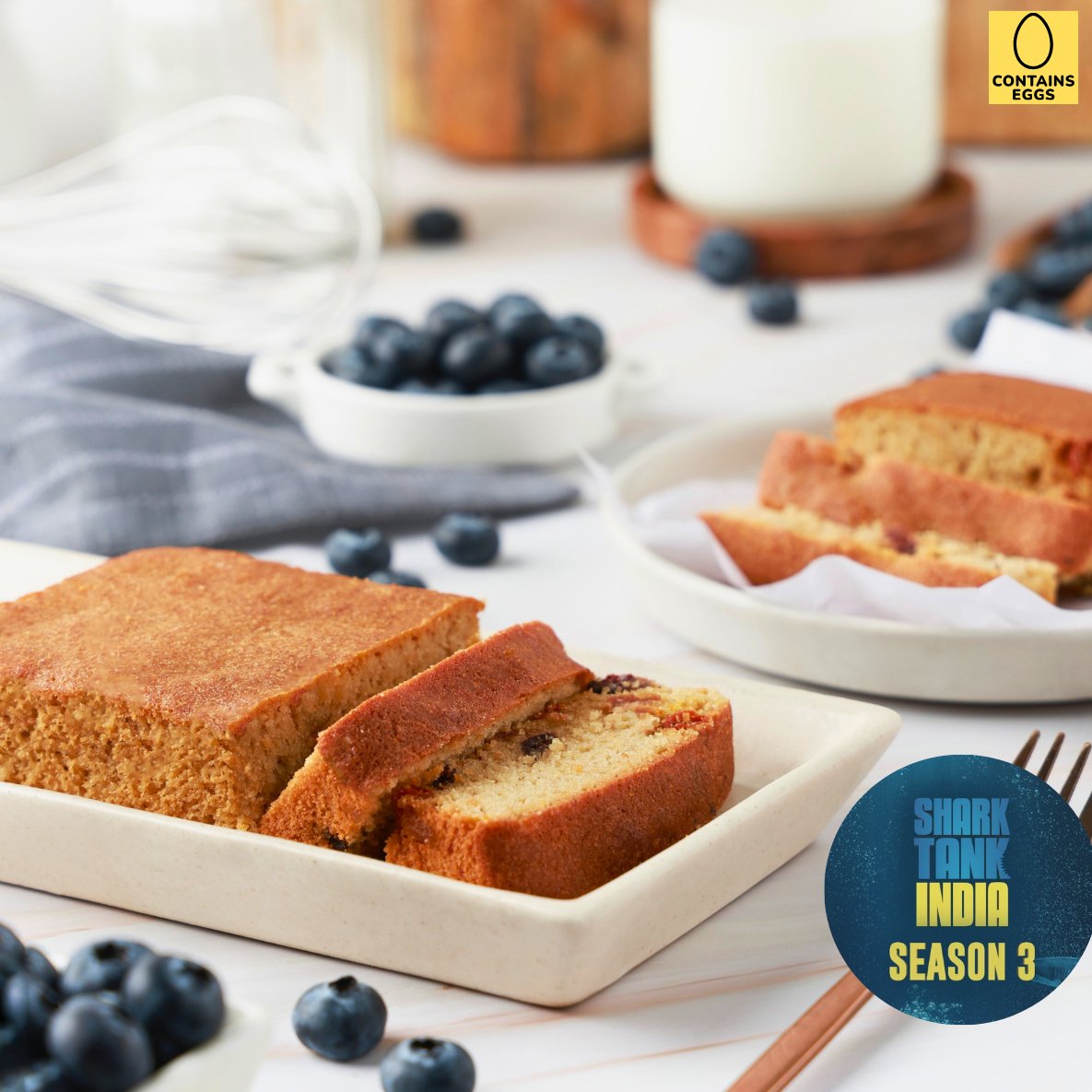


Berries Almond Cake - Sugar-Free, Keto, Gluten-Free, Diabetic-friendly (contains egg)


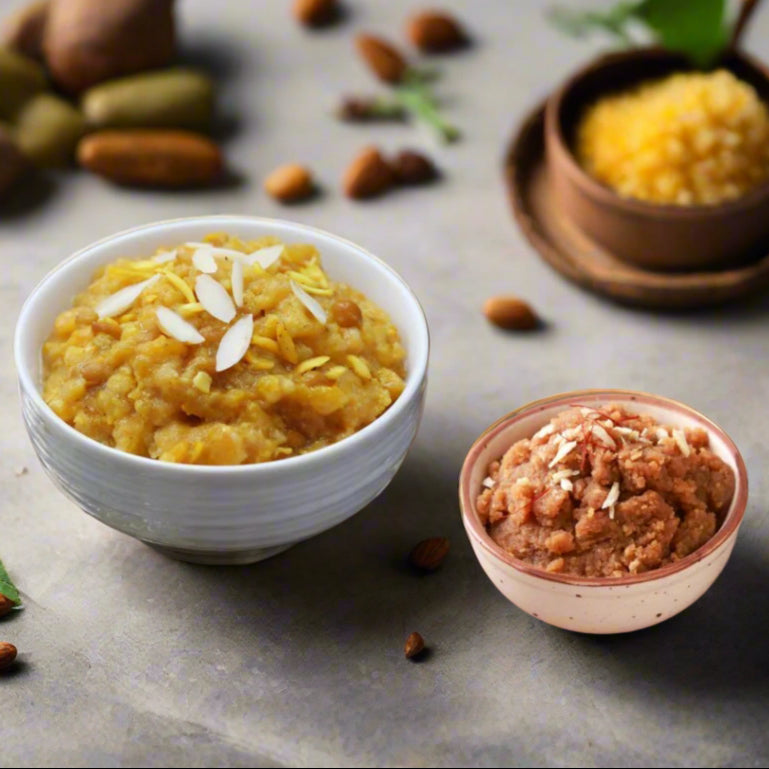
Sugar free Halwa combo @499


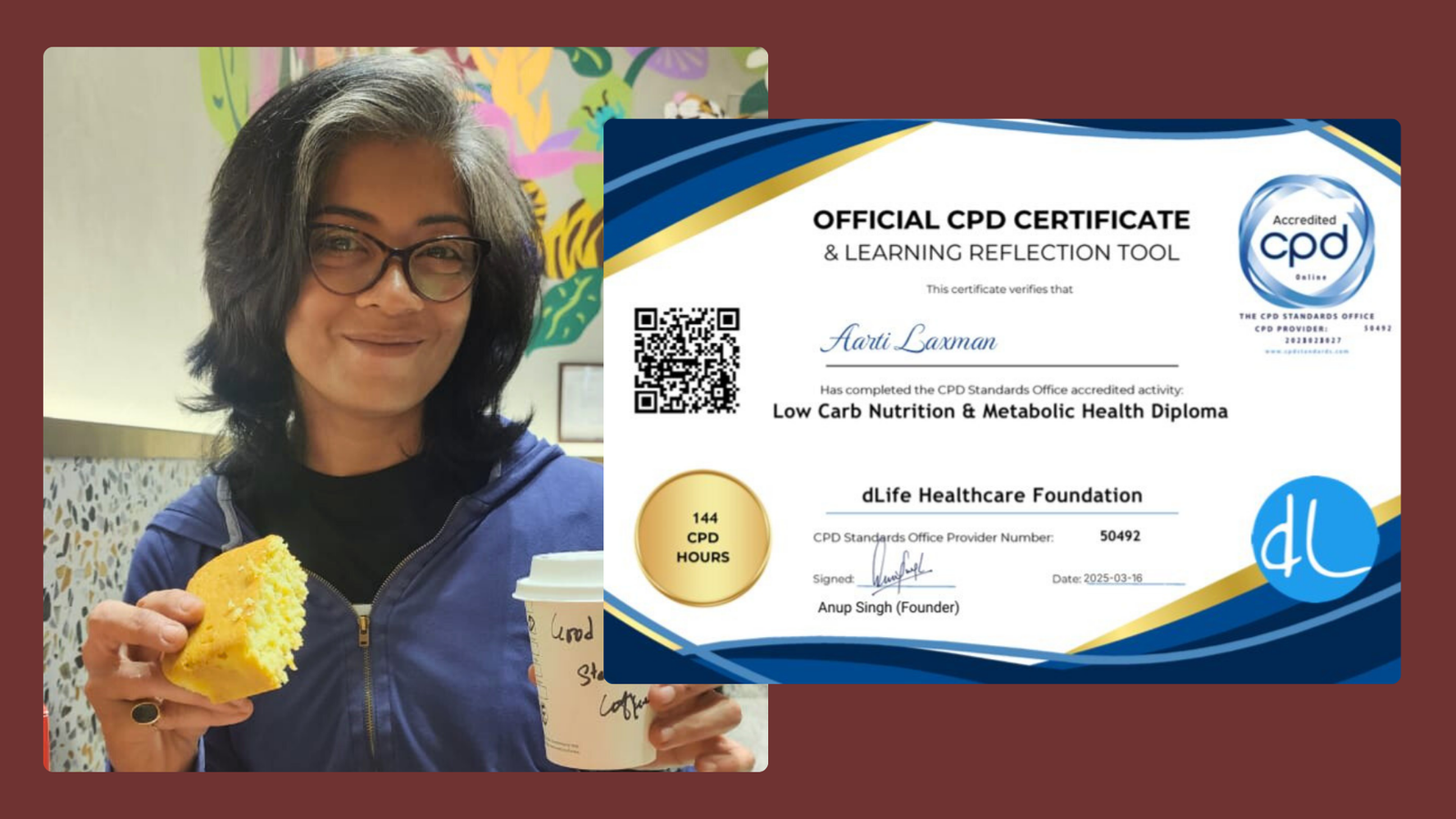
Aarti Laxman (Founder)
Artinci is founded by Aarti Laxman, a certified Metabolic coach in the Low-Carb Nutrition & Metabolic Health domain from dLife.in, India’s only legally tenable course in this subject—recognized by the NSDC (under the Ministry of Skill Development & Entrepreneurship, Govt. of India). It’s also internationally accredited by the CPD Standards Office UK, with a global record of 144 CPD hours—the highest for any course of its kind. The accreditation is both nationally valid and globally recognised in over 50+ countries..
Festive Gifting in Artinci
Let customers speak for us
All about Sugar and sugar-free
In recent years, the surge in health awareness and lifestyle diseases has spurred unprecedented growth in the sugar-free food and beverage market. Consumers concerned about diabetes management, weight control, and overall wellness are increasingly opting for sugar-free alternatives, fueling a transformative shift in dietary habits worldwide. Diabetes and Obesity Drive Demand The rising prevalence of diabetes and obesity is a major catalyst behind the growing demand for sugar-free products. With millions affected globally, people are actively seeking options that help regulate blood sugar levels without sacrificing taste. Sugar-free beverages and foods provide these benefits by using alternative sweeteners such as stevia, sucralose, or monk fruit, which offer sweetness without the calorie burden of sugar. This shift is especially pronounced in regions with high diabetes rates like North America and Asia-Pacific, where consumers prioritize healthier lifestyle choices to avoid chronic conditions. Weight Control and Wellness Trends Alongside diabetes concerns, weight management remains a top priority for many health-conscious consumers. Excess sugar consumption is linked to weight gain, prompting individuals to choose sugar-free options to reduce calorie intake. The broader wellness trend, emphasizing preventive health and clean eating, further supports this movement. Sugar-free products align with demands for natural, organic, and functional foods that contribute to metabolic health, gut wellness, and energy balance. Market Growth and Innovation The global sugar-free food and beverage market is booming, with a valuation expected to reach over USD 67 billion in 2025 and continue growing at a healthy rate. This surge is driven by innovation in natural sweeteners, product reformulations, and expanding distribution channels such as online retail. Leading brands are reformulating popular beverages and introducing zero-sugar versions that maintain flavor and appeal. Additionally, the growth of functional sugar-free supplements enriched with minerals and plant compounds offers expanded choices for fitness enthusiasts and those seeking metabolic benefits. Online Shopping and Consumer Convenience E-commerce has played a vital role in accelerating the accessibility of sugar-free products. Online platforms provide personalized recommendations and subscription services, making it easier for consumers to discover and consistently obtain their preferred sugar-free foods and beverages. The convenience and educational content available online empower informed purchasing decisions, sustaining the upward trend. Conclusion The rising demand for sugar-free foods and beverages reflects a broader societal pivot towards health-conscious living. Driven by diabetes management, weight control priorities, and general wellness aspirations, this market is poised for continued expansion and innovation. As consumers increasingly seek products that support their health goals without compromising taste, the sugar-free revolution is reshaping how we approach nutrition and lifestyle in the 21st century. Reference: https://www.insightaceanalytic.com/report/global-sugar-free-food-and-beverage-market/1470 https://www.mordorintelligence.com/industry-reports/sugar-free-food-and-beverage-market https://www.futuremarketinsights.com/reports/zero-sugar-beverages-market https://www.fortunebusinessinsights.com/zero-sugar-beverages-market-113607

“सेहत की ओज: शुगर-फ्री भोजन और फिटनेस का सफर"
आजकल भागदौड़ भरी जिंदगी में अपना ध्यान रखना चुनौतीपूर्ण हो गया है। हालांकि, स्वस्थ भोजन, शुगर-फ्री डाइट और नियमित व्यायाम से न केवल वजन कम किया जा सकता है, बल्कि मानसिक और शारीरिक सेहत भी बेहतर होती है। शुगर-फ्री डाइट के फायदे अत्यधिक चीनी का सेवन शरीर में इंसुलिन बढ़ाता है, जिससे वजन बढ़ता है और डायबिटीज का जोखिम भी। शुगर-फ्री डाइट अपनाने से ऊर्जा में वृद्धि होती है, त्वचा साफ होती है और शरीर में ताजगी बनी रहती है। प्राकृतिक मिठास (फल, शहद, गुड़, आदि) को आहार में शामिल करें और प्रोसेस्ड फूड्स जैसे बिस्कुट, केक, और सॉफ्ट ड्रिंक्स से बचें। स्वस्थ आहार कैसे अपनाएं? हर रोज़ भोजन में ताजे फल, हरी सब्जियां, साबुत अनाज और दालें शामिल करें। खाने में विविधता रखें और आलू, शक्कर, प्रोसेस्ड स्नैक्स कम से कम लें। संतुलित डाइट से पोषण मिलता है, जिससे शरीर और दिमाग दोनों स्वस्थ रहते हैं। व्यायाम क्यों जरूरी है? रोजाना कम से कम 30 मिनट हल्का-तेज चलना, योग या किसी भी फिजिकल एक्टिविटी को अपनी दिनचर्या में जरूर शामिल करें। इससे न केवल वजन नियंत्रित रहता है, बल्कि मानसिक तनाव भी कम होता है और नींद बेहतर आती है। क्या न खाएं सफेद चीनी, मीठे स्नैक्स, पैक्ड जूस, एनर्जी ड्रिंक्स, केक, बिस्किट, आइसक्रीम आदि। ऐसे उत्पाद जिनके लेबल पर शुगर, ग्लूकोज, सिरप, फ्रुक्टोज, सुक्रोज, माल्टोज लिखा हो। संदर्भ : https://ckbirlahospitals.com/rbh/blog/what-to-eat-in-diabetes-easy-and-balanced-diet-chart-in-hindi https://www.lybrate.com/topic/diabetes-diet-chart-in-hindi/7b343ce7db6c49a61498dc39ffee3380 https://hindi.asianetnews.com/lifestyle/health-fitness/30-days-no-sugar-challenge-benefits-weight-loss/articleshow-lz5nb86 https://nutritionsource.hsph.harvard.edu/healthy-eating-plate/translations/hindi/

Which sugar-free sweetener is healthiest: stevia, monk fruit, erythritol, or sucralose?
Among the sugar-free sweeteners stevia, monk fruit, erythritol, and sucralose, stevia and monk fruit are generally considered the healthiest options, given their natural origins and minimal side effects when consumed in moderation. Recent studies raise concerns about erythritol’s possible cardiovascular risks, while long-term safety data for sucralose is still debated. Meta Description Discover which sugar-free sweetener—stevia, monk fruit, erythritol, or sucralose—is healthiest. Compare benefits, side effects, and safety to help you make an informed choice for diabetes, weight loss, or general health. Comparing Sugar-Free Sweeteners Stevia Stevia, derived from the Stevia rebaudiana plant, offers sweetness without calories and minimal impact on blood sugar, making it a favorite for diabetic and weight-conscious diets. Studies note potential additional benefits for blood pressure and gut health, though some users report a bitter aftertaste and rare side effects like nausea or hormone disruption, which are not conclusively proven. Monk Fruit Monk fruit extract, also a natural sweetener, is nearly calorie-free, doesn't affect blood glucose or insulin, and typically lacks the aftertaste associated with stevia. It’s well-tolerated, with centuries of traditional use and very limited reported side effects. Monk fruit is usually more expensive and less accessible than stevia. Erythritol Erythritol is a sugar alcohol often featured in low-carb and keto products. While it doesn’t raise blood sugar and is generally tolerated, recent research links high erythritol blood levels to increased risk of heart attack and stroke, warranting caution for those with cardiovascular risk factors. Some individuals also experience digestive discomfort when it’s consumed in large amounts. Sucralose Sucralose is an artificial sweetener found in many diet foods and beverages. Most studies suggest it’s safe in typical dietary amounts, but some research raises questions about its effect on gut health and metabolism over long-term use. Its synthetic nature and lack of nutritional benefit may be off-putting for those preferring natural products. Sweetener Comparison Table Sweetener Source Calories Blood Sugar Effect Notable Benefits Concerns / Side Effects Stevia Plant (stevia) 0 None/Very Low May lower BP, natural Bitter aftertaste, rare hormone/gut effects Monk fruit Plant (fruit) 0 None Mild taste, natural Expensive, few reported side effects Erythritol Fermented ~0 None Gut health, low GI Heart concern, digestive upset Sucralose Synthetic 0 None Widely used Possible gut/metabolic effects References : 1. https://www.foodandnutritionjournal.org/volume13number1/the-battle-of-natural-sweeteners-a-comprehensive-guide-to-monk-fruit-and-stevia/ 2. https://www.medicalnewstoday.com/articles/319837 3. https://www.medicalnewstoday.com/articles/322769 4. https://www.cspi.org/article/which-low-calorie-sweeteners-are-safe-and-which-arent

मधुमेह आहार चार्ट | डायबिटीज में क्या खाएं और क्या न खाएं
मधुमेह (डायबिटीज) के लिए आहार चार्ट में सही और संतुलित भोजन बहुत जरूरी होता है ताकि रक्त शर्करा नियंत्रित रहे। इसमें कम कार्बोहाइड्रेट, अधिक फाइबर, प्रोटीन, और हेल्दी फैट्स वाले आहार को प्राथमिकता दी जाती है। नीचे मधुमेह के लिए हिंदी में एक सरल आहार चार्ट और क्या खाएं-क्या न खाएं की जानकारी दी गई है। मधुमेह आहार चार्ट (डायबिटीज में क्या खाएं) सुबह तड़के एक गिलास गुनगुने पानी के साथ मेथीदाना नाश्ता: मल्टीग्रेन या ब्राउन ब्रेड की एक स्लाइस, एक कम कैलोरी वाला फल (सेब, अमरूद, नाशपाती), छाछ या लो-फैट दूध मिड मॉर्निंग स्नैक्स: ग्रीन टी के साथ फ्रूट सलाद या मुट्ठी भर बादाम/अखरोट दोपहर का भोजन: 2 चपाती (साबुत अनाज से बनी), 1 कटोरी ब्राउन राइस या मिलेट्स, सब्जी, दाल, सलाद शाम का नाश्ता: अंकुरित दाल, मूंगफली, या भुने चने, ग्रीन टी रात का भोजन: साबुत अनाज से बनी रोटी, सब्जी, दाल या लो-फैट प्रोटीन स्रोत सोने से पहले: हल्दी वाला दूध या छाछ मधुमेह में क्या न खाएं मीठे पदार्थ जैसे मिठाई, केक, चॉकलेट, शुगर युक्त जूस, कोल्ड ड्रिंक मैदा, सफेद ब्रेड, सफेद चावल, रिफाइंड कार्बोहाइड्रेट तला-भुना, जंक फूड, पैकेज्ड स्नैक्स उच्च वसा वाले डेयरी और रेड मीट महत्वपूर्ण सुझाव भोजन में 50% गैर-स्टार्च वाली सब्जियाँ, 25% लीन प्रोटीन और 25% साबुत अनाज शामिल करें भागों का ध्यान रखें और दिन भर छोटे-छोटे भोजन करें नियमित व्यायाम और वजन नियंत्रित रखें यह आहार चार्ट मधुमेह नियंत्रित करने में मदद करता है और रक्त शर्करा को स्थिर बनाए रखता है, जिससे स्वास्थ्य बेहतर रहता है। स्रोत 1. https://www.lalpathlabs.com/blog/diabetes-diet-chart-in-hindi/






